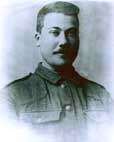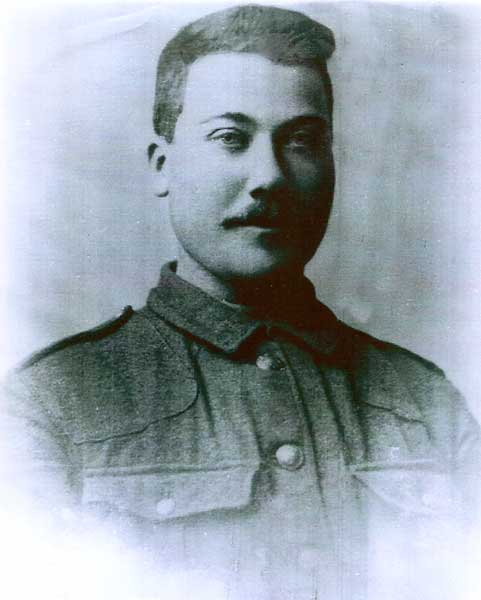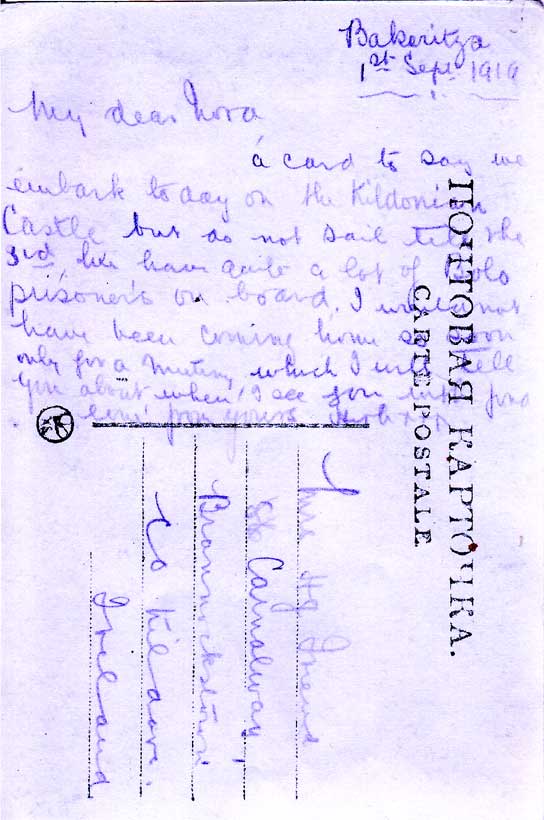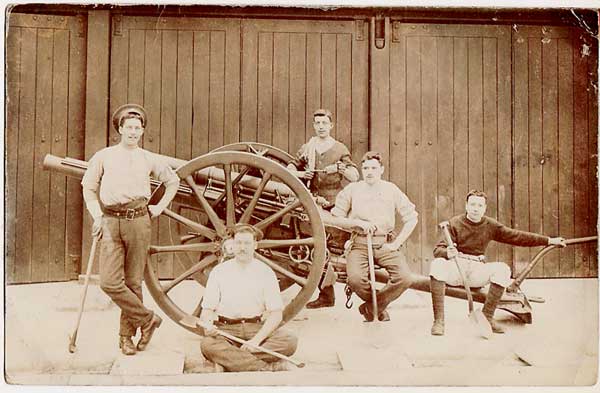 |
Remembrance
- The Yorkshire Regiment, First World War CSM Herbert FRIEND, MM 9970 Close window to return to main page |
 |
Company Sergeant Major Herbert FRIEND, MM. 9970
2nd Battalion he Yorkshire Regiment.
Twice wounded in France, - in July 1915 and December 1916.
Served in Russia in 1918 - 1918 with the Green Howards.
Died in 1928.
A fuller description of CSM Friend's life and service has been provided by
Alan Gilbert(<alangilbert.carlow@gmail.com>), who is the grandson of
CSM Herbert Friend. Photos and information are as below.

CSM Herbert Friend, MM
Herbert Friend was born on the 16th. June 1885. According to his baptismal certificate he was Christened on the 8th July 1885, at St John’s Church Meerut, India. He was the son of Lance Corporal George Friend, (Kings Own Scottish Borders ) and his mother was Maria Friend. Nothing is known about his childhood. Perhaps it was spent in India, or his father may have returned to England with the family after his term of duty there.
The next that is known about Herbert, he is a soldier and the
information is from the beautiful post cards sent from France to his fiancée
Nora Clark. The address given on almost all the post cards was “ Dug
out in France” a reference to the trenches of WW1. Nora was the daughter
of Thomas Clark a retired Army Farrier Sergeant, 15th Hussars. Nora lived
with her nine siblings in a pretty gate lodge on the Harristown Estate in
County Kildare, Ireland. Her father who had also served in India worked as
a Farrier on the Harristown Estate owned by the famous Hugenot family, La
Touche. No doubt Herbert met his fiancée while stationed at the near
by Curragh Camp. The Curragh was then, and is presently a large military camp
situated on the plains of Kildare.
Nora collected postcards, she inadvertently provided the historical material
for this biography as each post card is dated.
On the 21st January 1916 Nora and Herbert were married in the beautiful Carnalway
Church (Anglican) located on the La Touche Estate. Herbert was home on leave
from the British Expeditionary Force in France. Evidently Herbert returned
to the War in France and post cards sent home from Loos- en – Gopelle,
Vermelles, Millebosc or Vimy, all offer reassurance of his good health, and
expressions of loving devotion to his wife. Herbert survived his tour of duty
in France, however on the 11th of July 1918 on a post card sent from the Union
Jack Club in London he expects to arrive in Aldershot by 9am, the next correspondence
in Oct. of the same year, records him in Dundee. Post cards from then on come
from the Orkneys, Kirkwall, and in 1919 from Russia. The Expeditionary forces
were sent to Russia in support of the White Russians against the Bolsheviks.
The theatre of war was located around the White Sea Port of Archangel. There
is a remarkable break in correspondence from the 3rd Dec. 1918 until the 14th
of June 1919. According to Herbert’s sister in law the late Mrs Mary
Elliott and youngest of the Clark family, the ships were frozen in the ice.
Mrs Elliott also remembered stories from the war and often referred to the
brutality of the Russian fighters. Fallen men were spiked with a sword to
ascertain if they were dead. Herbert received a bullet wound to the chest
while on active duty in Russia. While some of the postcards sent home from
Russia depict snow scenes and one of a wooden house which belonged to “Peter
the Great” the most remarkable is a card dated 1st September 1919.
Embark today 1st aboard “Kildonian Castle”.
This was the postcard which denoted the end of the War for Herbert. Never
before has he mentioned events of war in his correspondence. On this postcard
he refers to “Bolo” prisoners and a “mutiny.”
“I would not have been coming home so soon only for a mutiny, which
I will tell you about when I see you”
The mutiny may have been a deciding factor to end International participation
in White Russia. Another postcard on the 7th September 1919
“ I can hardly realise that I am on my way home”
Herbert did return to his beloved Nora and the home coming took place at the
gate lodge in Harristown, he was in poor health possibly from the bullet wound
and extreme cold winter in Russia.
Herbert and Nora returned to Reading, Berkshire. They had two children, George
and Enid. On the 14th Jan 1924 Herbert was given a presentation clock and
the inscription reads “A token of esteem from members of the Mess to
Coy Sgt. Major Friend 2nd. Bn. The Green Howards on leaving the service”.
Sadly Herbert died on the 18th. Nov. 1928 aged 43, from pulmonary tuberculosis,
while his children were still very young. He was awarded the Military Medal
posthumously. His widow Nora had also developed tuberculosis and brought her
two young children back to her ageing parents who were still living in the
gate lodge on the Harristown Estate in County Kildare. She died a short time
later. Their son George Friend joined the RAF in 1938 and was killed in action
during WW2 on 23 Jul.1941. This event ended ( as far as is known) a long family
tradition of service in the armed forces, for Sgt Major Herbert Friend whose
father, father in law, brothers and brothers in law had served in the forces
of an Empire. Herbert who must have faced the possibility of dying for five
years during the Great War passed away in the presence of his beloved Nora
to whom he had sent dozens of postcards which expressed his loving devotion
as an absent husband.
------------> Return to the top of the Page
A postcard written by Herbert Friend on 1 September 1919, as he was about to return home on the "Kildonian Castle".

------------> Return to the top of the Page

A photo of a Field Gun team, with CSM Friend seated (front)
-----------------> Return to the Top of the Page
The following information relates to CSM Friend in the Green Howards Gazette;-
July 1915. Volume XXIII, 268, 60. Sgt H Friend, 9970. 2nd Battalion. Wounded.
July 1915. Volume XXIII, 268, 66. Corporal H Friend, 9970.
Dec 1916. Volume XXIV, 285,121. CSM H Friend, 9970. Wounded.
The following extract from "The History of the Green Howards" by
Geoffrey Powell and John Powell relates to the service of the Green Howards
in Russia in 1918 - 1919.
-------------------------
8. THE INTER-WAR YEARS: 1918-39
For some Green Howards the war was far from over. Two New Army units, the
6th and 13th Battalions, had been reconstituted at the end of July for service
in, of all places, northern Russia. The officers were mainly Green Howards,
the rest a very mixed lot. Of the 422 reinforcements who joined the 6th Battalion
during the last fortnight of July, fifty-seven only were Green Howards. The
others had been culled from a score of different corps and regiments, a polyglot
collection of English, Scots and Welsh. But how did British troops become
involved in the struggle between Whites and Reds in the Russian Civil War?
For most of the 1914-18 War the Germans had virtually closed the Baltic and
Black Sea ports to Allied shipping, leaving Murmansk, near the Norwegian border,
as the sole Russian winter lifeline to the west, because the Gulf Stream kept
it largely free of ice. The collapse of Russia in 1917 posed new threats to
the Allies, not least of which was the likelihood of German submarines being
brought in sections by train to Murmansk, there to be reassembled and deployed
against Allied convoys. In June 1918 a small, international expeditionary
force, including British, Poles, French, Canadians, Italians, Finns, Serbs
and Americans, under British command, invaded northern Russia and seized Murmansk.
Far too many of these troops were either semi-trained recruits or battered
old soldiers, and they had not been trained or equipped for Arctic warfare.
In the event, their original role of retrieving munitions and equipment supplied
to the Tsarist government had been widened, almost inadvertently, into support
for the White Russians, a hopeless and invidious task which, even if successful,
could hardly have led to Russia re-entering the war.
By the time the Green Howards arrived, the war against Germany was over and
the Allies, with their main base at Archangel, were holding a vast frontage
covering the White Sea and extending some 500 miles southwards. Although the
ancient ship that carried their two Battalions had sailed on 17 November,
a chapter of maritime accidents had delayed their arrival until 26 November.
Until February 1919 their time was to be filled with grinding guard duties,
fatigues and train protection, the men working in temperatures down to minus
40 degrees centigrade. Daylight lasted for three hours.
Battalions were split up into detached companies, but the 6th Battalion was
detailed to form a mobile company, nearly 200 strong. Trained by Sir Ernest
Shackleton, the Antarctic explorer, this company quite quickly took to snow-shoes
and skis; baggage was carried on sleighs and winter clothing was provided
similar to that used on polar expeditions. When the Bolshevik threat from
the south against Murmansk slackened, Major-General Edmund Ironside, the Allied
commander in North Russia, moved the two Green Howard units round to the Archangel
area, on the far side of the White Sea, where the Red forces were far more
active. Part of the 13th Battalion travelled by sea to Archangel in an ice-breaker;
for the rest of the Green Howards it was to be an unusual journey. It began
and finished by train, but the middle 400-mile section was by trotting horse-
or reindeer-drawn sleighs, each carrying two men. At night shelter was found
in the comfortable and solidly built peasant houses where the men, greatcoats
often frozen solid, could thaw out. What was remarkable was the high standard
of living then enjoyed by the kulaks.
At the end of February the 13th Battalion reached the Seletskoe area, some
seventy miles south of Archangel, in excellent shape, a fact commented upon
by General Ironside who saw them arrive.6 But on 26 February he received a
horrifying telegram from Lieutenant-Colonel Lavie of the Durham Light Infantry,
an able and experienced officer, who had taken over command of the 13th Battalion
only three weeks before. His men had refused to parade.
General Ironside, who spoke more than a dozen languages fluently, including
Russian, was a hulk of a man, frightening to confront. Afterwards he was to
become CIGS. Beset with every conceivable problem from his hotch-potch international
force, he had not anticipated mutiny among his British regiments. Travelling
by sleigh, he caught up with the Battalion the following evening to find that
Lavie had everything in hand. Lavie had gone straight to the billets and ordered
the men to fall in without arms. This they did, but two ex-Army Pay Corps
sergeants, neither of whom had been overseas before, had stepped forward and
declared that the Battalion would do no more fighting. Sending a lance-corporal
and a file to fetch their rifles, Lavie ordered them to escort the two sergeants
to the guardroom. That ended the trouble and in due course the Battalion marched.
The two sergeants were tried by court-martial and sentenced to be shot, but
Ironside had received secret orders direct from HM the King that no death
sentences were to be executed. The men were given life imprisonment, but were
released in 1931.
Such trouble was hardly surprising. There had been a number of mutinies in
France and England by both British and Canadian troops, impatient for their
ineptly handled demobilization. How much worse it was for men who had experienced
the miseries and dangers of that Russia winter, few of whom understood why
they were still fighting when the war had ended months earlier. In any case,
many disapproved of the British intervention.
Nor did it help when the Daily Express insisted that 'The frozen plains of
Russia were not worth the bones of a single British Grenadier'.
Russian mud, which made much of the country all but impassable when the thaw
arrived, was to receive the bones of many Green Howards during the coming
months. To halt the steady Bolshevik pressure from the south towards Archangel
involved holding the single railway line and the rivers, the sole arteries
of communication with the rest of Russia. So it was that fighting devolved
upon small forces. In this way, the Green Howards fought for the next three
months, often in company detachments and switched from one area to another
as the threat changed. More often than not they would be supporting and bolstering
White Russian units which Ironside was equipping and training in the hope
that the anti-Bolshevik forces might rally and form a stable government in
North Russia, so allowing the British and Allied troops to leave. In defending
and attacking small isolated posts, six officers of the 6th Battalion and
thirty-six other ranks are mentioned as having been killed or wounded. The
13th was more fortunate, losing only three men. The Communists were not the
only enemy. When summer came mosquitoes swarmed, bringing malaria as well
as making life almost unbearable for those operating in the forests.
In June 1919 Ironside's British battalions, described in the official despatch
as 'composed of low-category men selected originally as unsuitable for service
in France and further severely tried by the rigour of an arctic winter' were
replaced by fresh troops, newly recruited youngsters. The Green Howards and
the rest of those low-category men embarking at Archangel for demobilization,
now tough and battle-hardened, were to be denied the special campaign medal
which Ironside considered their due.
With a spate of serious mutinies among the White Russian units emphasizing
the futility of the campaign, all the Allied troops were soon afterwards withdrawn.
The last had gone by October 1919, sailing before Archangel became ice-bound
for yet another winter. Seldom had British troops fought in a more unpromising
cause.
-----------------> Return to the Top of the Page
In a further postscript to this story, The Seaham Weekly News for the week ending 22 August 1919 reported that;-
"H.M.T. Czar arrived in the Tyne, from Murmansk last Friday, with about 1,800 British and Italian troops from the Syren Force North Russia. Amongst them were about 100 officers, NCO’s and men of the 6th and 13th Battalions Yorkshire Regiment, who went out last October. This party included Corporal G.S. Boggan of 12 Maureen Terrace and Private J.J. Williams of 35 Church Street. The latter, before proceeding to the Murmansk coast, fought in France. He wears the Military Medal and 1914 ribbon. Major Muir, RAMC, of Horden also travelled home by the same boat.
Private John Joseph Williams, MM. 18021 7th Battalion Yorkshire
Regiment.
Address: 35 Church Street Seaham Harbour (Co. Durham)
-----------------> Return to the Top of the Page